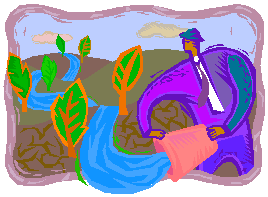|
|
|
Water is a renewable resource |
|
|
|
||
How does it work --Natural wetlands purify water by removing nutrients and filtering out pathogens and toxic chemicals. This is a biological process that relies on bacteria that reside in the wetland. Bacteria decompose organic compounds. In doing this they deplete the water of oxygen. Because water passes very slowly through the wetland cells during normal flows, effective filtration is mostly a matter of retaining the water in contact with the substrate for extended periods, allowing time for the microbes to do their work. The emergent plants, such as cattails, grow in proportion to the amount of nutrients produced by microbial decomposition or simply contained in the wastewater stream. When these plants are harvested, nutrients are exported from the system. Our goal at CHMF is to grow plants with economic value in our wetland. We have successfully grown water hyacinth using our waste stream as fertilizer. We plan to begin annual sales of other wetland plants such as aquatic irises once they have been propagated. For more information of the biological processes involved, consult the links below. |
|||






